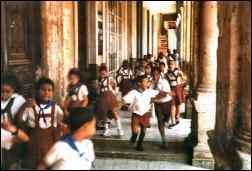A 6-year-old Cuban boy drowned on October 13 in an attempt to reach the U.S. illegally, and I can’t help thinking that a sane and humane policy on Cuba could have prevented his death. Apparently, the 33-foot boat was trying to outrun a US coast guard when it capsized, and the boy was trapped underneath. Thirty adults were rescued.
Current immigration law (that applies only to Cubans) dictates that if an illegal immigrant makes it all the way across the sea to American soil, they can stay legally in the U.S.
If, on the other hand, he or they are caught at sea by the Coast Guard, then they are returned to Cuba. Such logic has been termed “the wet foot-dry foot policy,” perhaps in memory of that great inspirational thinker Groucho Marx (not to be confused with that other equally brilliant though somewhat less articulate Harpo Marx).
President Lyndon B. Johnson signed the Wet Foot-Dry Foot policy into law on November 2, 1966. I suspect that Johnson was a Marx Brothers fan, but don’t know for sure. The policy will forever bind the comedian and president.
Imagine the Marx Brothers as top advisers to President Johnson and directed by Norman Z. McCleod:
President Johnson: I don’t know what to do about this Castro feller… He’s survived our attacks, our assassination attempts, our Cuban terrorists…
Zeppo: He’s a made out of a Teflon that a guy!
Groucho: He’s flesh and blood just like any other immortal dictator. Julius Caesar, Benito Mussolini, Hitler, Gandhi, Ronald McDonald!
President Johnson: Gandhi was not a dictator. He was a great man!
Zeppo: So was Ronald McDonald!
Groucho: I heard they both sold cheeseburgers at one time, and Castro looks like he’s eaten a lot of cheeseburgers. I tell you, there’s a connection there and I think we should explore it.
The men pace the oval office, nervously rubbing their chins.
President Johnson (mumbles): I didn’t know Gandhi sold cheeseburgers…
Suddenly Harpo bursts into the room on roller skates and a big overcoat. Everyone crowds around him as he pantomimes an idea. In the process he honks his horn several times.
Groucho: I get it! We’ll kill him with laughter!
Zeppo: Yes! We make new crazy immigration policy. He die laughing.
President Johnson looks confused, but after Groucho articulates the plan and Harpo honks his horn a few times in agreement, he smiles.
Johnson: It is funny… the Wet Foot, Dry Foot Immigration Policy.
The rest, as they say, is movie history and immigration policy. But seriously…
If the boat had slowed down when the coast guard approached on October 13, everyone would’ve been sent back, and that 6-year old boy would not have drowned.
The Wet Foot-Dry Foot policy continues to do what it has always done—to encourage Cubans to risk theirs and their children’s lives by attempting to cross the Florida Straits into U.S. territory. This policy has also encouraged a new form of smuggling, and according to the Chicago Tribune, the U.S. Coast Guard picked up 2,712 Cubans at sea in the past year.
You’d think that after the Elían Gonzalez situation a few years ago we’d have learned to apply the same immigration principles to Cubans that we apply to immigrants from Venezuela and Jamaica (no visa, no entry) if only to save lives.
The fact that we’re so willing to trade these deaths for bad word-of-mouth on Castro says much more about us.
Peace.



